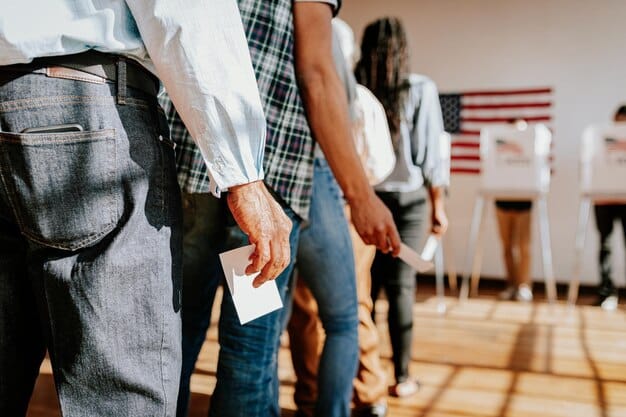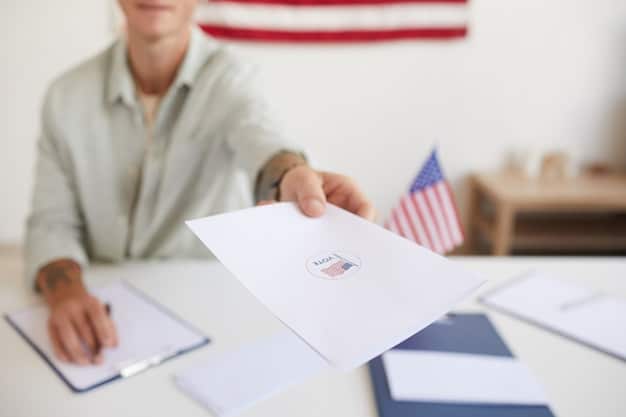Understanding the Updated US Voting Rights and Election Procedures

Anúncios
Understanding the updated US voting rights and election procedures involves examining key changes in voter identification laws, registration processes, and access to polling locations, all of which significantly affect participation and fairness in elections.
The bedrock of any democracy is the right and ability of its citizens to vote. In the United States, this right has been a hard-won battle, continually evolving through legislative action and judicial interpretation. To truly engage in the democratic process, it’s crucial to have a solid understanding the updated US voting rights and election procedures.
Anúncios
The Evolution of Voting Rights in the US
Voting rights in the United States have undergone significant transformation since the nation’s founding. Initially, suffrage was limited to white, male property owners. Over time, through constitutional amendments and legislative actions, these restrictions have been dismantled, albeit with continuous challenges and ongoing debates.
Key Milestones in Voting Rights History
Understanding the current state of voting rights requires a look back at pivotal moments that shaped the landscape. Key legislative acts and constitutional amendments have played a crucial role.
Anúncios
- 15th Amendment: Granted African American men the right to vote in 1870, though its enforcement was initially limited.
- 19th Amendment: Gave women the right to vote in 1920, marking a significant victory for the women’s suffrage movement.
- Voting Rights Act of 1965: Prohibited racial discrimination in voting, addressing historical barriers faced by African Americans, particularly in the South.
- 26th Amendment: Lowered the voting age to 18 in 1971, recognizing the civic engagement of young adults.
These milestones reflect a continuous effort to expand and protect the franchise, but challenges persist as new regulations and legal interpretations emerge.
Constitutional amendments and legislative actions have progressively expanded suffrage, yet challenges to voting rights continue to arise, underscoring the need for vigilance and advocacy.
Current Voter Identification Laws
Voter identification laws, requiring voters to present identification at the polls, are a contentious aspect of election administration. Proponents argue that these laws are necessary to prevent voter fraud, while opponents contend that they disproportionately affect minority, low-income, and elderly voters, creating unnecessary barriers to voting.
Types of Voter ID Requirements
Different states have different types of voter ID requirements, ranging from strict photo ID laws to more lenient options.
- Strict Photo ID Laws: Require voters to present a valid photo identification, such as a driver’s license or passport, to cast a ballot that will be counted.
- Non-Photo ID Laws: Allow voters to present non-photo identification, such as a utility bill or bank statement, to verify their identity.
- Affidavit Options: In some cases, voters who cannot provide required identification can sign an affidavit attesting to their identity.
The impact of these laws on voter turnout, particularly among marginalized groups, is a subject of ongoing debate and research.
Voter identification laws vary significantly by state, with strict photo ID requirements potentially disenfranchising vulnerable populations, sparking debates about voter fraud versus access to the ballot box.
Changes in Voter Registration Processes
Voter registration is the initial step in exercising the right to vote. Recent changes in registration processes, including online registration, automatic voter registration (AVR), and same-day registration, aim to enhance accessibility and participation.
Innovations in Voter Registration
Several states have adopted innovative approaches to streamline voter registration and increase voter rolls.
- Online Voter Registration: Allows eligible citizens to register to vote online, simplifying the process and reducing paperwork.
- Automatic Voter Registration (AVR): Automatically registers eligible citizens when they interact with government agencies, such as the Department of Motor Vehicles.
- Same-Day Registration: Permits eligible citizens to register and vote on the same day, eliminating registration deadlines and potentially increasing turnout.
These reforms have demonstrated the potential to modernize and expand voter registration, but implementation challenges and political considerations can influence their effectiveness.
Modernizing voter registration through online platforms, automatic enrollment, and same-day options aims to boost participation, though successful implementation hinges on addressing practical and political hurdles.
Access to Polling Locations and Early Voting
The accessibility of polling locations and the availability of early voting options play a crucial role in facilitating voter turnout. Factors such as the number and location of polling places, as well as the availability of transportation, can significantly impact voter participation.
Expanding Voting Options
Early voting and vote-by-mail options have gained popularity as a convenient way for voters to cast their ballots.
- Early Voting: Allows voters to cast their ballots in person at designated locations before Election Day, providing flexibility and reducing lines on Election Day.
- Vote-by-Mail: Enables voters to request and return their ballots by mail, offering a convenient option for those unable to vote in person.
- Drop Boxes: Secure locations where voters can deposit their completed mail-in ballots, providing an additional option for ballot return.
However, debates surrounding the security and integrity of mail-in voting persist, influencing policies and public perception.
Expanding voting options through early voting and vote-by-mail aims to accommodate diverse voter needs, but ensuring security and public trust remains a central concern in policy debates.
The Role of Technology in Elections
Technology plays a significant role in modern elections, from voter registration and electronic voting machines to cybersecurity and election administration. While technology can enhance efficiency and accessibility, it also raises concerns about security and accuracy.
Ensuring Election Security
Maintaining the security and integrity of electronic voting systems is a critical challenge in modern elections.
- Auditing and Recounts: Regular auditing of electronic voting machines and procedures helps ensure accuracy and detect potential discrepancies.
- Cybersecurity Measures: Protecting election systems from cyberattacks and hacking attempts is essential to safeguarding the integrity of the vote.
- Transparency and Oversight: Promoting transparency in election administration and providing oversight mechanisms can build trust and confidence in the process.
Striking a balance between technological innovation and election security remains a paramount concern for election officials and policymakers.
Technology’s role in elections offers opportunities for efficiency, but safeguarding systems from cyber threats and ensuring transparency are critical to maintaining public confidence in the democratic process.
Legal Challenges and Court Decisions
Voting rights are frequently the subject of legal challenges and court decisions, shaping the interpretation and enforcement of election laws. Landmark cases and ongoing litigation continue to influence the scope and application of voting rights.
Key Court Cases
Several key court cases have had a significant impact on voting rights in the United States.
- Shelby County v. Holder (2013): Struck down a key provision of the Voting Rights Act of 1965, removing federal oversight of election law changes in certain states.
- Veasey v. Perry (2014): Challenged Texas’s strict voter ID law, alleging that it discriminated against minority voters.
- Husted v. A. Philip Randolph Institute (2018): Upheld Ohio’s voter purges, allowing the state to remove voters from the rolls if they failed to vote in multiple elections and did not respond to a confirmation notice.
These cases highlight the ongoing legal and political battlesOver access to the ballot box and the interpretation of voting rights protections.
Legal challenges and court decisions constantly reshape the landscape of voting rights, with ongoing cases influencing the interpretation and enforcement of election laws across the country.
| Key Point | Brief Description |
|---|---|
| 🔑 Voter ID Laws | Vary by state, some require photo ID, others accept non-photo IDs or affidavits. |
| 💻 Voter Registration | Online registration, automatic registration, and same-day registration are expanding access. |
| 🗳️ Early Voting & Mail | Offer flexibility, but face scrutiny regarding security and integrity. |
| ⚖️ Court Decisions | Shape the interpretation and enforcement of voting rights laws. |
Frequently Asked Questions
▼
The Voting Rights Act of 1965 is a landmark federal law that prohibits racial discrimination in voting. It aimed to overcome legal barriers that prevented African Americans from exercising their right to vote, particularly in the Southern states.
▼
Automatic voter registration (AVR) automatically registers eligible citizens to vote when they interact with certain government agencies, such as the Department of Motor Vehicles. This streamlines the registration process and increases voter rolls.
▼
Strict photo ID laws require voters to present a valid photo identification, such as a driver’s license or passport, to cast a ballot that will be counted. These laws are controversial due to their potential impact on certain voter groups.
▼
Early voting allows voters to cast their ballots in person at designated locations before Election Day. This provides flexibility and reduces lines on Election Day, making it easier for people to participate in the electoral process.
▼
In Shelby County v. Holder (2013), the Supreme Court struck down Section 5 of the Voting Rights Act, which required certain states with a history of discrimination to obtain federal approval before changing their election laws. This decision significantly altered federal oversight of elections.
Conclusion
As voting rights and election procedures continue to evolve in the United States, it is essential for citizens to stay informed and engaged. Understanding the changes, challenges, and legal battles surrounding voting is crucial for protecting the integrity of the democratic process and ensuring that every eligible citizen has the opportunity to exercise their right to vote.







